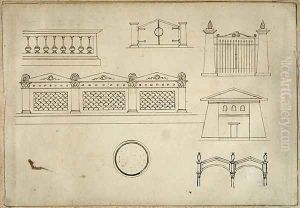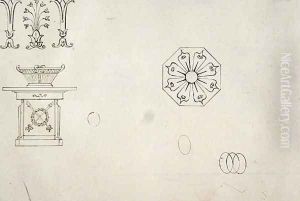Thomas Hope Paintings
Thomas Hope was a Dutch and British merchant, banker, author, philosopher, and art collector who was born on August 30, 1769, in Amsterdam, Netherlands. He hailed from a wealthy family of Scottish descent who had established themselves in the Dutch Republic in the 17th century. Hope inherited a tradition of collecting art from his ancestors, and his wealth allowed him to expand on this interest, eventually shaping him into a significant connoisseur and patron of the arts.
In 1784, following the death of his father, Thomas Hope and his family moved to London. There, he continued to grow the family's banking business as well as his art collection. Hope's travels throughout Europe, the Ottoman Empire, and Egypt between 1787 and 1795 had a profound influence on his taste and later contributions to design and aesthetics. He was particularly interested in antiquities and the art of the ancient world, and his extensive travels allowed him to study these firsthand.
Hope was central to the introduction and popularization of the neoclassical style in England. He was influential in the Regency style's development, which was a phase of the neoclassical style distinctive to Britain. Hope's book, 'Household Furniture and Interior Decoration' (1807), was pivotal in disseminating the neoclassical style. It illustrated his vision for interior design and included designs for furniture and other decorative arts.
In 1799, Hope purchased a large house on Duchess Street in London, which he remodeled to display his collection of art and antiquities. This house, which became known as the 'Hope Gallery,' was open to the public and served to inspire and educate artists and designers. Thomas Hope also designed his own furniture and interiors, which were innovative in their merging of different classical styles and motifs.
Additionally, Thomas Hope was a writer, and his novel 'Anastasius' or 'Memoirs of a Greek' published in 1819, was a significant work that influenced the perception of the East and was admired by contemporaries, including the poet Lord Byron.
Hope's contributions to art and design were not limited to his lifetime. His influence continued throughout the 19th century, as the neoclassical and Regency styles he championed became widely adopted in Europe and America. Thomas Hope's legacy is also preserved through his writings and the designs he left behind, which continued to inspire generations of designers and collectors.
Thomas Hope passed away on February 3, 1831, in London, leaving behind a rich legacy as a patron of the arts and a pivotal figure in the history of design and decorative arts.

